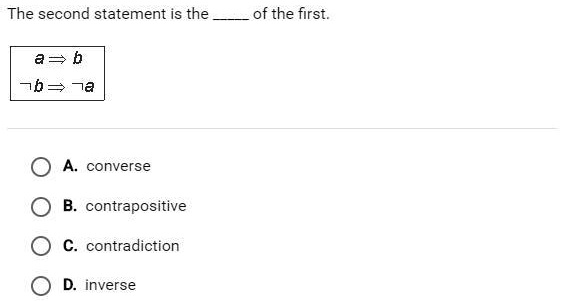The second statement is the ____ of the first

The Correct Answer and Explanation is:
The correct answer is B. contrapositive.
The original logical statement provided is “a implies b” which is symbolically written as a ⇒ b. The second statement is “not b implies not a” written as ¬b ⇒ ¬a. This second statement is the contrapositive of the first.
To understand this, recall the definitions of related logical forms:
- The converse of a ⇒ b is b ⇒ a.
- The inverse is ¬a ⇒ ¬b.
- The contrapositive is ¬b ⇒ ¬a.
Contraposition involves two operations: first, negating both the hypothesis and conclusion, and second, switching their order. If you begin with a ⇒ b, its contrapositive becomes ¬b ⇒ ¬a. This transformation preserves the logical truth of the original statement. In formal logic, a statement and its contrapositive are always logically equivalent. That means if one is true, so is the other.
To visualize this, suppose a stands for “it is raining” and b stands for “the ground is wet.” The statement a ⇒ b reads as “If it is raining, then the ground is wet.” The contrapositive ¬b ⇒ ¬a says, “If the ground is not wet, then it is not raining.” Both statements convey the same logical relationship.
By contrast, the converse b ⇒ a says “If the ground is wet, then it is raining.” While that may feel true in some situations, it is not logically equivalent to the original statement. Many other factors could explain the ground being wet.
Thus, the relationship between a ⇒ b and ¬b ⇒ ¬a is that of a statement and its contrapositive, which is why the correct answer is B. This distinction is essential in mathematical proofs and logical reasoning.
